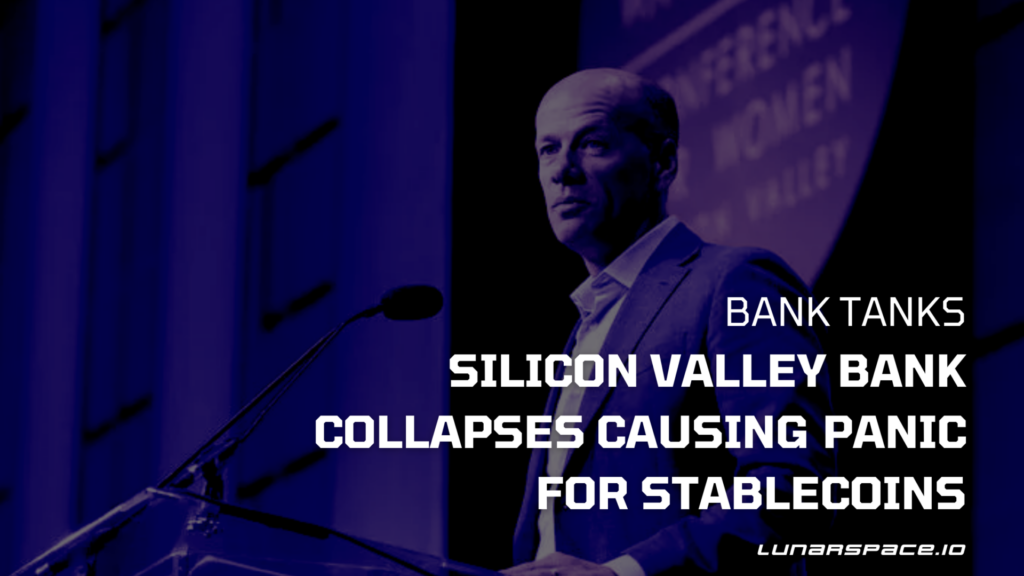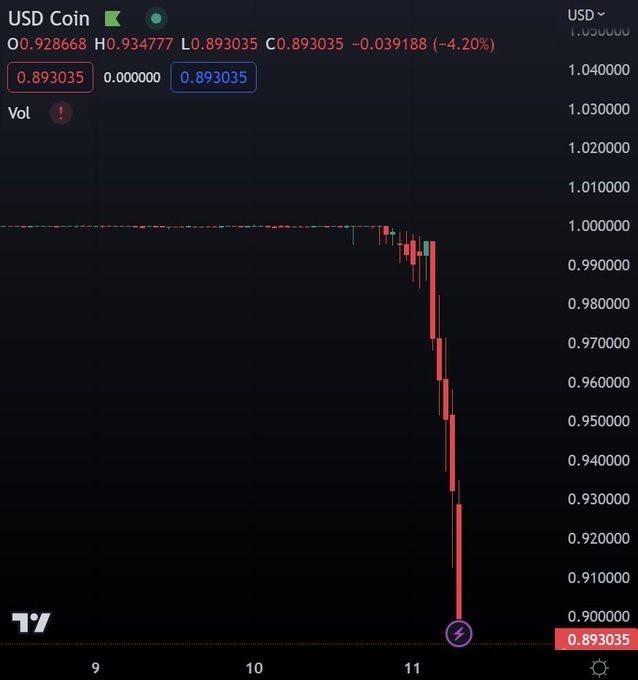The Collapse of Silicon Valley Bank and The Effects on Web3, Stablecoins, and the Cosmos Hub
How the De-pegging of $USDC Spells Trouble for the Web3 Ecosystem
by Decentranaut
March 2023
The Collapse of Silicon Valley Bank
On Friday, March 10th, 2023, the crypto community was hit with another massive blow as Silicon Valley Bank (SVB) collapsed, triggering a de-pegging of the USDC stablecoin and sending shockwaves throughout the entire industry. This collapse has far-reaching implications, not just for the Cosmos Hub, but for the entire web3 ecosystem and the tech industry.
“It’s with an incredibly heavy heart that I’m here to deliver this message,” he said in a video seen by Reuters. “I can’t imagine what was going through your head and wondering, you know, about your job, your future.” – SVB CEO Greg Becker
As of Friday, the FDIC was officially named receiver of Silicon Valley Bank after California banking regulators gave it the axe. Becker, the longtime CEO of SVB has stated he is working with banking regulators to find a partner for the bank, but he can’t make any “guarantees”.
Silicon Valley Bank has been a critical player in the web3 ecosystem, providing banking services to many of the most innovative and promising projects in the space. Its collapse has sent ripples throughout the industry, as many of these projects will now be left without a banking partner. This is a huge setback for the entire ecosystem, as it continues the downward trend of despair for web3 companies to operate within the traditional financial system.
The De-pegging of $USDC
The collapse of Silicon Valley Bank has sent shockwaves throughout the entire web3 and tech industry, and one of the most immediate impacts has been the de-pegging of the $USDC stablecoin. $USDC, currently trading under $0.90 on Kraken, has wiped out over 15% of its market cap so far, causing widespread panic among traders and investors. This event shines a bright light on the risks associated with relying on stablecoins that are backed by centralized entities, and the potential fallout from SVB’s collapse.
Centralized Stablecoins in Trouble
Circle, the company behind USD Coin ($USDC), is among the cryptocurrency firms hit by the collapse of Silicon Valley Bank (SVB) last week. Circle had $3.3 billion of its $40 billion of USDC reserves at the now-collapsed bank. With the loss of its banking partner, Circle is now faced with the challenge of finding a new partner quickly to continue operating in the short term. This situation has put into focus the reliance on centralized entities to back stablecoins like $USDC.
The de-pegging of $USDC has caused concern among traders and industry experts alike, raising questions about the stability and sustainability of the stablecoin industry. Despite the challenges, Circle has reassured users that $USDC is still backed by a diverse range of banking partners and creditworthy institutions and that the company is working to secure new banking partners.
The Glaring Risks of Centralized Stablecoins
Centralized stablecoins, such as $USDC, are digital currencies that are designed to maintain a fixed price against a stable asset, typically the US dollar. These coins are backed by a centralized entity, which holds reserves of the stable asset to ensure that the coin’s value remains stable. However, recent events have highlighted the risks associated with centralized stablecoins.
The de-pegging of $USDC first highlights the obvious risk associated with centralized stablecoins: counterparty risk. When a stablecoin is backed by a centralized entity, such as Circle, the value of the coin is dependent on the financial stability of that entity. If the entity experiences financial difficulties or goes bankrupt, the value of the coin may be affected. In the case of $USDC, the collapse of Silicon Valley Bank, where Circle had deposited a significant portion of its USD Coin reserves, led to concerns about the stability of $USDC and contributed to the coin’s de-pegging from the US dollar.
The de-pegging of $USDC also highlights the risk of liquidity risk associated with centralized stablecoins. When a stablecoin is de-pegged, it means that the coin is no longer trading at its fixed price. In the case of $USDC, the coin’s value dropped to $0.89, which means that it was no longer trading at parity with the US dollar. This can result in a lack of liquidity for the coin, which can make it difficult for investors to buy and sell the coin.
Industry-Wide Ramifications
The collapse of SVB and the de-pegging of $USDC have implications for the entire web3 and tech industry. Many innovative and promising projects in the space rely on stablecoins and banking partners like SVB to operate. With these entities facing increasing regulatory scrutiny and potentially collapsing, the future of the web3 ecosystem is uncertain. Moreover, the collapse of SVB highlights the risks associated with the traditional banking system’s hostile stance towards blockchain companies as it may become increasingly difficult for these companies to find banking partners and operate within the traditional financial system, which could hamper innovation and growth in the industry.
Increased Scrutiny from Regulators
The collapse of SVB and the de-pegging of $USDC are likely to attract increased scrutiny from regulators. Stablecoins have come under increasing regulatory pressure in recent months, with regulators concerned about their potential to facilitate money laundering and other illicit activities.
The collapse of SVB only adds to these concerns, as it highlights the risks associated with relying on centralized entities to back stablecoins. Regulators may now be more inclined to impose stricter regulations on stablecoins and the companies that issue them, which could have far-reaching implications for the entire industry.
$USDC De-pegging and the Cosmos Hub
The Cosmos Hub, which is a decentralized network for blockchain interoperability and the main hub for the Cosmos ecosystem, may suffer indirectly from the $USDC debacle. The Cosmos Hub enables various blockchains to communicate and exchange value with each other, and $USDC is one of the many cryptocurrencies that can be traded on the Cosmos Hub. However, as $USDC is a centralized stablecoin, its recent de-pegging and subsequent drop in value to $0.89 can have negative implications for the Cosmos Hub.
Firstly, the de-pegging of $USDC can cause a loss of confidence in stablecoins in general, which can affect the trading volume and liquidity of $USDC on the Cosmos Hub. As a result, the demand for $USDC may decrease, which can lead to a decrease in the overall trading volume on the Cosmos Hub.
Secondly, the Cosmos Hub may suffer from reputational damage due to its association with $USDC. As the Cosmos Hub is a platform for various blockchains to connect and trade, any issues with $USDC can reflect poorly on the Cosmos Hub and its ability to provide a safe and reliable trading environment.
Thirdly, the de-pegging of $USDC can potentially lead to a loss of value for users who hold $USDC on the Cosmos Hub. As the value of $USDC has dropped to $0.89, users who hold $USDC may have experienced a loss of value in their holdings. This can lead to a loss of confidence in the Cosmos Hub as a trading platform and affect the willingness of users to hold $USDC on the platform.
Golden Ratio Staking, a Cosmos Ecosystem and Interchain Validator, took to twitter to express the gravity of the situation while ensuring the safety of Cosmos ecosystem, stating “Cosmos ecosystem needs to pray to whoever it is they pray to, that $USDC is fine. Yes, vast majority is in treasuries and doesn’t have exposure.”
Overall, while the impact of the $USDC debacle on the Cosmos Hub may not be as direct as other platforms, the negative implications can still be significant. As a platform that relies on trust and confidence from its users, any issues with $USDC can potentially affect the reputation and trustworthiness of the Cosmos Hub.
Lessons from FTX, Terra, and Other Failures
While the collapse of SVB has sent shockwaves through the industry, it is not the first major hurdle that the web3 ecosystem has faced. In recent years, there have been several high-profile failures, including FTX and Terra.
In May 2021, FTX suffered a major outage, which left traders unable to access their accounts or withdraw their funds.
In a perfect summary with well-timed humor, Twitter user @ChainLinkGod.eth tweeted about the collapse of TerraUSD, a stablecoin pegged to the US dollar, which led to the bankruptcy of several companies, including 3AC, Voyager, and BlockFi. These events have highlighted the risks associated with relying on centralized entities and the need for greater decentralization in the industry.
@ChainLinkGod.eth’s tweet went into detail about the extent of the damage caused by the collapse of TerraUSD, which was described as a massive Ponzi scheme. The collapse wiped out $20 billion in UST and $40 billion in LUNA, leading to the insolvency of the largest crypto hedge fund, 3AC. 3AC had borrowed funds from the largest crypto lenders, each of which went insolvent after bank runs occurred, causing a market-wide credit crunch. This had a knock-on effect on other companies, including Celsius, Voyager, and BlockFi, which were bailed out by FTX/Alameda, but were found to be complete frauds and criminals themselves.
The bank run created a second contagion wave, leaving Voyager/BlockFi greatly damaged again. Genesis Lending, under the DCG conglomerate, also went bankrupt due to Alameda/FTX exposure, leaving a $3 billion shortfall. Even traditional finance (TradFi) was impacted, with the collapse of two banks that were key banking partners for crypto, including Silvergate (FTX’s banking partner) and SVB (Circle’s banking partner for $USDC and most tech startups).
In addition to the failures of these companies, the SEC has also been trying to strong-arm the industry, from shutting down Kraken’s staking product to calling Paxos’ stablecoins a security and shutting down BUSD, among other actions. Meanwhile, various banking regulators have been pressuring banks to refuse to onboard crypto companies as clients, forcing them to go overseas and use sketchy counterparts.
The web3 industry is still in its early stages and is largely unregulated, which can lead to a lack of accountability and transparency. The industry is also highly speculative, which can lead to volatility and greed. Additionally, the decentralized nature of many web3 projects can create challenges in terms of governance and decision-making, which can lead to conflicts and failures.
These failures serve as a reminder of the importance of resilience in the face of adversity and the need to learn from setbacks to grow and mature as an industry. The web3 industry is still in the early stages, evolving and maturing more and more every day. It will take time and effort to address these challenges and build a more stable and sustainable ecosystem.
Silver Linings From a Massive Bank Collapse
With SVB seemingly out of the picture, web3 companies will be forced to become more self-sufficient and innovative in the ways that they operate. This could lead to the development of new and more robust decentralized financial tools and services, which would ultimately benefit the entire industry.
The Emergence of CoFi
The emergence of CoFi protocols could also provide a potential solution to the challenges faced by web3 companies in the traditional financial system. CoFi protocols are designed to provide decentralized financial services, including lending and borrowing, without relying on centralized intermediaries like banks. As a result, they could provide a more resilient and flexible solution for web3 companies to access financial services. With the collapse of SVB and increased scrutiny from regulators, the potential for CoFi protocols to rise as a solution for web3 companies cannot be ignored.
What is CoFi?
Collaborative Finance, or CoFi for short, is an emerging concept that combines centralized and decentralized elements to create a more inclusive and sustainable financial system. CoFi seeks to address some of the limitations of both centralized and decentralized finance (CeFi and DeFi) by combining the benefits of both models. In a CoFi system, centralized financial institutions, such as banks or asset managers, work alongside decentralized networks, such as blockchain-based platforms or peer-to-peer lending platforms, to provide a range of financial services.
CoFi: The Way Forward
“Systemic collapse is not my ideal way for you to learn about the importance of what we’re working on, but indeed, CoFi is the future of sustainable finance.” – Ethan Buchman via Twitter on Friday.
In the wake of the $USDC de-peg and the collapse of SVB, the limitations of centralized stablecoins have become more apparent. CoFi offers a potential solution by allowing for the integration of centralized financial institutions with decentralized networks to create a more resilient financial system. For example, CoFi systems can provide the scalability, security, and regulatory compliance of centralized systems, while also offering the transparency, accessibility, and cost-efficiency of decentralized systems.
Some potential applications of CoFi in response to the current challenges include collaborative lending platforms that use blockchain technology to connect borrowers and lenders, hybrid asset management platforms that offer both traditional and cryptocurrency-based investment options, and decentralized exchanges that work in partnership with centralized custodians to provide increased security and ease of use. These CoFi projects could help to create a more diverse and stable financial ecosystem that is less susceptible to the risks associated with centralized stablecoins and financial institutions.
In summary, Collaborative Finance offers an interesting development in the evolution of financial systems and may have the potential to create more inclusive, efficient, and sustainable financial markets. By integrating centralized and decentralized elements, CoFi could emerge as a great answer to the de-pegging of $USDC and the collapse of SVB, providing a way forward for the financial industry to move towards a more resilient and collaborative future.
Resilience is Key
It is important to learn from the failures of SVB, FTX, Terra, and other companies in the industry, and to take steps to mitigate the risks associated with centralized systems. As the industry continues to mature and face increased scrutiny from regulators, it is crucial to remain vigilant and adaptive to new challenges and opportunities.
While the de-pegging of $USDC and the collapse of SVB have caused significant disruption in the crypto industry, there is still hope for $USDC’s recovery. With Circle actively seeking new banking partners and the stablecoin backed by a diverse range of institutions, there is reason to believe that $USDC can continue to operate and even regain its peg in the future. Additionally, the incident serves as a reminder of the importance of decentralization and reducing reliance on centralized entities in the crypto industry. As the industry matures and adapts to these challenges, there is still great potential for stablecoins and other crypto assets to continue to grow and play a significant role in the global financial system.
This article was written with assistance from AI Generative Pre-training Transformer called ChatGPT and was curated by Decentranaut.











